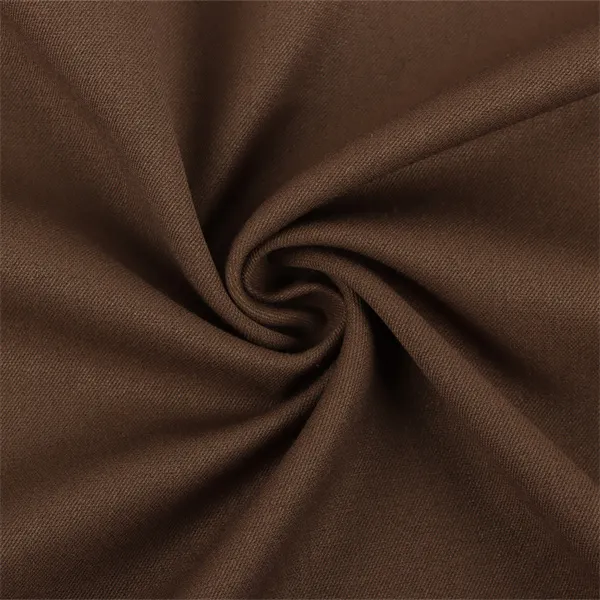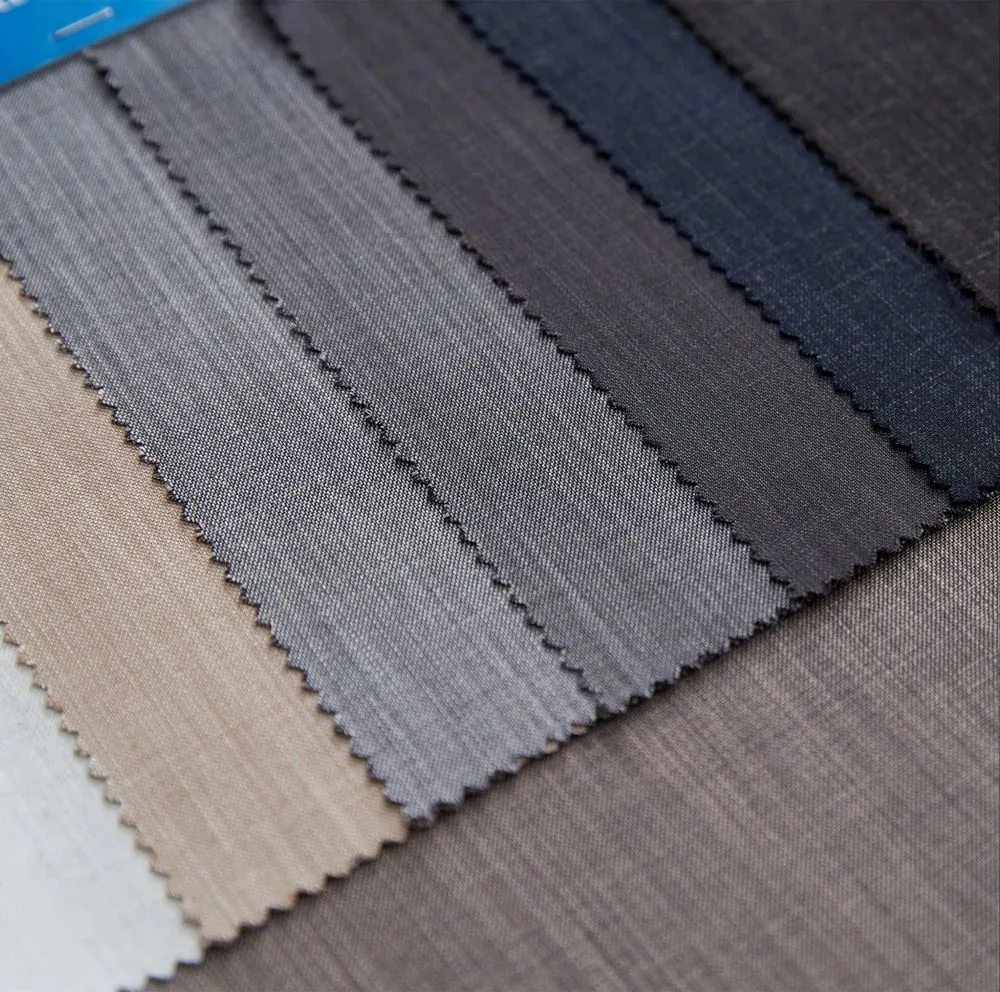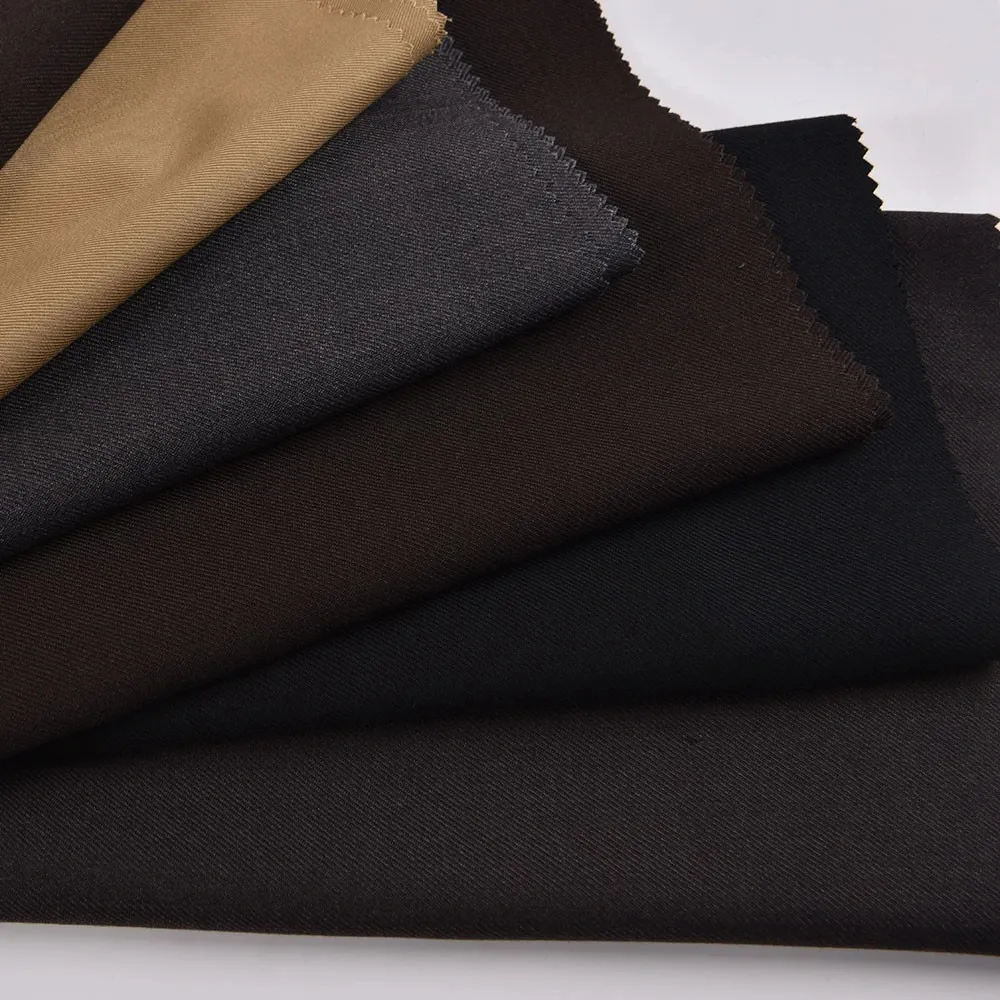80/20 Poly Viscose TR Suiting Fabric: Uniforms & Workwear
The Foundation of Professional Attire: Understanding TR Suiting Fabric
In the demanding landscape of professional and industrial attire, the selection of textiles is paramount, directly influencing comfort, durability, and corporate image. A prime example of such a meticulously engineered material is the 80% Polyester 20% Viscose TR Suiting Fabric for Uniform/ Workwear/ Frock tr mens plaid suits fabric. This sophisticated blend combines the exceptional strength and resilience of polyester with the soft hand-feel and breathability of viscose, also known as rayon. This synergistic composition results in a fabric that not only presents a sharp, professional appearance but also withstands the rigors of daily wear in diverse environments. TR, an acronym for Tetron Rayon, specifically denotes a polyester-rayon blend, highlighting its dual-component nature optimized for performance characteristics essential in uniform and workwear applications. Industries ranging from corporate offices and hospitality to healthcare and heavy manufacturing consistently choose this fabric due to its intrinsic qualities such as superior wrinkle resistance, excellent color retention, and ease of maintenance. Unlike natural fibers that may require extensive care or purely synthetic materials that can lack comfort, this specific blend achieves a harmonious balance, delivering both functional superiority and aesthetic appeal. It offers a solution that significantly reduces operational costs associated with garment replacement and professional cleaning, making it an economically viable and highly practical choice for large-scale procurement in B2B contexts where consistency and longevity are non-negotiable. Furthermore, its versatility allows for various finishes and patterns, including intricate plaid designs, catering to specific branding requirements and fashion trends in men's suiting. This makes it an indispensable material for designers and procurement managers focused on delivering high-performance, visually appealing, and cost-effective textile solutions. The fabric's inherent ability to resist creasing ensures that uniforms maintain a crisp, professional look throughout the workday, a crucial factor in industries where appearance directly reflects brand standards and employee professionalism. Its robust construction also contributes to an extended service life, which is critical for reducing the total cost of ownership for uniforms and workwear, particularly for sectors that experience high turnover or require frequent laundering cycles. The inclusion of viscose imparts a natural drape and softness, enhancing wearer comfort without compromising the fabric's structural integrity, bridging the gap between high-performance synthetics and traditional natural fibers. This thoughtful engineering makes it an ideal choice for uniforms that demand both resilience and sophisticated aesthetics.
The Precision Craft: Manufacturing Process of TR Suiting Fabric
The creation of high-performance textiles like the 80% Polyester 20% Viscose TR Suiting Fabric for Uniform/ Workwear/ Frock tr mens plaid suits fabric involves a sophisticated multi-stage manufacturing process, meticulously controlled to ensure consistent quality and desired performance characteristics. It commences with the precise blending of polyester staple fibers and viscose rayon fibers, where the ratio of 80% polyester to 20% viscose is critical for achieving the optimal balance of durability, drape, and comfort. This initial blending ensures a homogeneous mix before the fibers are spun into yarns. Yarn production involves carding, drawing, and roving processes, culminating in the spinning of a blended yarn with specific counts and twist levels, which dictate the final fabric's strength and texture. Subsequently, these blended yarns are prepared for weaving, a process where warp (longitudinal) and weft (transverse) threads are interlaced on advanced weaving looms. Common weave patterns for suiting fabrics include twill, plain, or specific dobby weaves for plaid designs, each chosen for its aesthetic and structural properties. After weaving, the grey fabric undergoes a series of critical wet processing stages, including desizing, scouring, and bleaching to remove impurities and prepare it for dyeing. Dyeing is performed using high-temperature, high-pressure techniques for polyester and reactive or direct dyes for viscose, ensuring excellent colorfastness and uniform shade penetration across the blend. The final and arguably most crucial stage is finishing, which imparts the fabric's functional attributes. This includes calendering for smoothness, sanforizing for shrinkage control, and specialized chemical treatments for wrinkle resistance, anti-pilling, and sometimes even water-repellency or anti-microbial properties. Throughout this entire process, stringent quality control measures are implemented at every stage. This includes adherence to international standards such as ISO 9001 for quality management, AATCC (American Association of Textile Chemists and Colorists) for testing colorfastness to washing, light, and crocking, and ASTM (American Society for Testing and Materials) for evaluating tensile strength, tear strength, and pilling resistance. These rigorous inspections ensure that each batch of fabric meets the specified technical parameters and performance criteria, guaranteeing a product with a reliable service life of typically 3-5 years under normal uniform wear and maintenance, suitable for demanding sectors like corporate, healthcare, and industrial workwear.

Technical Specifications and Performance Metrics for TR Suiting Fabric
Understanding the technical parameters of 80% Polyester 20% Viscose TR Suiting Fabric for Uniform/ Workwear/ Frock tr mens plaid suits fabric is crucial for B2B procurement professionals and technical decision-makers to ensure alignment with specific application requirements. This fabric is engineered with precise specifications to deliver optimal performance. Its composition, typically 80% polyester and 20% viscose, is the cornerstone of its balanced properties. Polyester contributes significantly to strength, dimensional stability, and wrinkle resistance, while viscose provides a desirable soft hand, breathability, and improved moisture absorption compared to 100% polyester. The typical fabric weight ranges from 180 GSM (grams per square meter) to 350 GSM, allowing for versatility in different uniform and suiting weights, from lighter summer wear to heavier winter garments. Standard width is usually 58/60 inches (approximately 147-152 cm), optimizing material yield for garment production. Key performance indicators include colorfastness, assessed against AATCC standards for washing (Grade 4-5), light (Grade 4-5), and rubbing (dry: Grade 4-5, wet: Grade 3-4), ensuring long-lasting color vibrancy even after repeated laundering and exposure. Shrinkage control is vital for garment integrity, typically maintained below 3% in both warp and weft directions after washing, in accordance with ISO 6330. Pilling resistance, measured by ASTM D3512 or ISO 12945-2 (Martindale abrasion test), often achieves a rating of 4 or higher, indicating minimal fiber entanglement and surface fuzziness. Furthermore, the fabric exhibits excellent tensile strength (e.g., Warp ≥ 800N, Weft ≥ 600N) and tear strength (e.g., Warp ≥ 80N, Weft ≥ 60N) as per ASTM D5034/D1424, underscoring its robustness for demanding workwear applications. The weave type, often a twill or plain weave, contributes to its smooth surface and good drape. The specific blend also allows for effective moisture management, providing comfort even in varied climates. These precise technical data points provide a quantifiable basis for assessing the fabric's suitability for high-performance uniforms and workwear, guaranteeing that the end product will meet stringent industry benchmarks for durability, appearance retention, and wearer comfort.
| Parameter | Specification (Typical) | Testing Standard | Significance for Performance |
|---|---|---|---|
| Composition | 80% Polyester, 20% Viscose | ISO 1833-1/7 | Optimized blend for durability, drape, and comfort. Polyester for strength, Viscose for feel. |
| Weight (GSM) | 180-350 g/m² | ISO 3801 | Determines fabric thickness and suitability for seasonal wear (lighter for summer, heavier for winter). |
| Width | 147-152 cm (58/60 inches) | ISO 22198 | Standardized for efficient garment cutting and reduced fabric waste. |
| Weave Type | Twill, Plain, Dobby (for plaid) | Visual Inspection | Influences fabric texture, drape, and visual appearance, including patterns like plaid. |
| Colorfastness to Washing | Grade 4-5 | AATCC 61 / ISO 105-C06 | Ensures color retention after repeated laundering, crucial for uniform longevity. |
| Colorfastness to Light | Grade 4-5 | AATCC 16 / ISO 105-B02 | Prevents fading from sunlight exposure, maintaining aesthetic integrity. |
| Pilling Resistance | Grade 4+ (5000 cycles) | ASTM D3512 / ISO 12945-2 | Minimizes unsightly fiber balls, preserving the smooth appearance of the fabric. |
| Shrinkage (Warp/Weft) | Max 3% | ISO 6330 | Ensures garments retain their size and fit after washing, crucial for uniform consistency. |
| Tensile Strength (Warp/Weft) | ≥ 800N / ≥ 600N | ASTM D5034 | Indicates resistance to breaking under tension, critical for the durability of seams and stress points. |

Diverse Applications and Strategic Industry Relevance
The inherent versatility and robust performance characteristics of 80% Polyester 20% Viscose TR Suiting Fabric for Uniform/ Workwear/ Frock tr mens plaid suits fabric make it an indispensable material across a broad spectrum of industries, particularly where professional appearance, durability, and comfort are non-negotiable. In the corporate sector, it is extensively used for business suits, blazers, and trousers, providing a crisp, polished look that resists wrinkling throughout long workdays and travel, reflecting a professional brand image. For the hospitality industry, including hotels, restaurants, and event management, the fabric is ideal for uniforms worn by front-of-house staff, chefs, and service personnel. Its easy-care properties, including machine washability and resistance to stains, contribute to lower maintenance costs and ensure that staff always look presentable. Healthcare facilities also benefit significantly; while not sterile, the fabric's durability and ability to withstand frequent high-temperature washes make it suitable for non-medical uniform components like administrative staff attire or general workwear, ensuring hygiene and longevity. Educational institutions, from private schools to universities, utilize this fabric for student uniforms and faculty attire, valuing its resilience against daily wear and tear and its ability to maintain color and form over prolonged periods, directly contributing to cost savings for families and institutions alike. Furthermore, in industrial settings requiring a balance of professionalism and practical functionality, such as light manufacturing, service technician roles, and logistical operations, this TR suiting fabric serves as an excellent choice for workwear. It provides comfort for extended shifts, durability to withstand demanding environments, and a professional aesthetic that helps maintain corporate identity even in operational roles. The fabric’s suitability for frock designs, commonly found in specific professional or ceremonial wear, further underscores its adaptive nature. Its consistent performance across these varied sectors underscores its strategic importance for B2B clients seeking reliable, high-quality textile solutions that align with their operational demands and brand values. Customer feedback consistently highlights the fabric's excellent drape, minimal creasing, and extended service life, which translates directly into reduced replacement cycles and enhanced overall value. For instance, a major hotel chain reported a 25% reduction in uniform replacement costs after switching to TR blend uniforms, alongside improved employee satisfaction regarding comfort and appearance.

Unpacking the Technical Advantages and Comparative Performance
The distinct advantages of 80% Polyester 20% Viscose TR Suiting Fabric for Uniform/ Workwear/ Frock tr mens plaid suits fabric are rooted in its optimized blend, delivering a suite of performance benefits that surpass those of single-fiber alternatives. Firstly, its superior wrinkle resistance is a hallmark, largely attributed to the polyester component's inherent resilience and the fabric's specialized finishing treatments. This means garments made from this fabric maintain a crisp, professional appearance throughout the day, significantly reducing the need for frequent ironing, a considerable operational advantage for large organizations. Secondly, the fabric boasts exceptional durability and abrasion resistance. Polyester fibers are renowned for their strength, making the fabric highly resistant to tearing, snagging, and general wear and tear, which directly extends the service life of uniforms and workwear, leading to substantial cost savings on replacements. Thirdly, color retention and colorfastness are critical, especially for brand uniformity. This TR blend exhibits excellent color vibrancy even after numerous washes and prolonged exposure to light, preventing fading and ensuring that uniforms consistently reflect brand guidelines. The viscose component, while contributing to a softer hand and improved breathability, also enhances moisture absorption compared to pure polyester, offering greater comfort in diverse climatic conditions and during extended wear periods. This characteristic is particularly beneficial in uniforms where comfort directly impacts employee productivity and satisfaction. Furthermore, compared to 100% natural fibers like wool or cotton, this TR blend offers superior dimensional stability, meaning garments are less prone to stretching or shrinking, maintaining their original fit and form. While 100% wool suits offer luxury, their high maintenance, susceptibility to moths, and creasing make them impractical for high-volume uniform programs. Similarly, 100% cotton workwear, though breathable, can wrinkle easily and may lack the required durability for heavy industrial use. The TR blend strikes an ideal balance, providing the professional drape and comfortable feel of natural fibers with the low-maintenance, high-performance attributes of synthetics, all while offering a highly cost-effective solution for large-scale uniform procurement. This fabric also demonstrates remarkable resistance to pilling, a common issue with blended fabrics, maintaining its smooth, clean surface over time.

Tailored Solutions: Customization and Bespoke Fabric Procurement
Recognizing the unique branding and functional requirements of diverse industries, suppliers of 80% Polyester 20% Viscose TR Suiting Fabric for Uniform/ Workwear/ Frock tr mens plaid suits fabric offer extensive customization options, transforming a standard textile into a bespoke solution. This flexibility is crucial for B2B clients aiming to differentiate their workforce attire and align it perfectly with their corporate identity and operational demands. Customization capabilities extend across several key dimensions. Clients can specify desired fabric weight (GSM) to suit seasonal needs or specific garment types, ranging from lighter shirting weights to heavier suiting and outerwear options. A vast array of color choices is available, precisely matched to Pantone codes or client-provided fabric swatches, ensuring accurate brand representation. Beyond solid colors, intricate weave patterns, including a wide variety of plaid designs, herringbone, or subtle textures, can be engineered to create unique visual appeals for tr mens plaid suits fabric. Furthermore, specialized finishes can be applied to impart additional functional properties. This might include enhanced wrinkle resistance for high-mobility roles, water-repellent treatments for outdoor or spill-prone environments, anti-static finishes for sensitive electronic environments, or anti-microbial treatments for healthcare and hospitality settings where hygiene is paramount. Yarn count and twist can also be adjusted to influence the fabric’s hand-feel, drape, and overall performance. For large-scale procurement, suppliers work closely with clients to develop comprehensive bespoke solutions, from initial sample development and laboratory testing to bulk production and streamlined logistics. This collaborative approach ensures that the final fabric not only meets all technical specifications but also perfectly aligns with aesthetic and budgetary requirements, providing a truly tailored uniform solution. Such partnerships often involve a detailed consultation process, where the supplier's technical experts provide guidance on the most suitable fabric specifications and finishes to achieve the client's specific performance goals while maintaining cost-effectiveness for uniform manufacturing.

Assured Quality, Reliable Partnership: Certifications and Support
For B2B clients, the assurance of quality and reliability is paramount when sourcing textiles, particularly for critical applications like uniforms and workwear. Suppliers of 80% Polyester 20% Viscose TR Suiting Fabric for Uniform/ Workwear/ Frock tr mens plaid suits fabric prioritize comprehensive quality assurance protocols and transparent operational practices to build lasting trust. This commitment is underpinned by adherence to rigorous international standards and certifications. Key among these is ISO 9001, which signifies a robust Quality Management System (QMS) ensuring consistent product quality, continuous improvement, and customer satisfaction throughout the manufacturing and delivery processes. Furthermore, compliance with environmental and social standards such as Oeko-Tex Standard 100 provides assurance that the fabric is free from harmful substances, making it safe for human skin and promoting sustainable manufacturing practices. Extensive in-house laboratory testing, alongside independent third-party verification, confirms that each batch of fabric consistently meets or exceeds published technical specifications for parameters like colorfastness, shrinkage, pilling resistance, and tensile strength, as outlined by AATCC, ASTM, and ISO testing methods. A clear warranty commitment typically covers manufacturing defects and ensures the fabric's performance within specified parameters for a reasonable period, providing peace of mind for bulk purchasers. Efficient logistics and a clear delivery cycle are also crucial elements of a reliable partnership. Standard lead times for stock items are often within 2-4 weeks, while customized orders may require 6-10 weeks, depending on complexity and order volume. Dedicated customer support, including technical assistance for fabric selection, care instructions, and prompt issue resolution, ensures a seamless procurement experience. This holistic approach, from stringent quality control and authoritative certifications to transparent service level agreements and responsive client support, establishes a foundation of trustworthiness essential for long-term B2B relationships in the textile supply chain, ensuring that the final garments deliver consistent performance and value.

Frequently Asked Questions (FAQ)
- Q: What are the primary benefits of 80% Polyester 20% Viscose TR suiting fabric over other blends?
A: This blend offers an optimal balance of durability, wrinkle resistance, and excellent color retention from polyester, combined with the soft hand, breathability, and comfortable drape of viscose. It provides a professional look with easy care, making it superior to 100% synthetics in comfort and drape, and to pure natural fibers in durability and wrinkle resistance for uniform applications. - Q: How should 80% Polyester 20% Viscose TR suiting fabric be cared for?
A: Generally, garments made from this fabric are machine washable in cold water on a gentle cycle. Tumble dry low or hang dry to minimize wrinkles. Ironing on a low to medium setting is usually sufficient if needed. Avoid harsh bleaches to preserve color and fabric integrity. Its inherent wrinkle resistance often means minimal ironing is required. - Q: Is this fabric suitable for all types of uniform applications?
A: Yes, its versatility makes it highly suitable for corporate uniforms, hospitality attire, school uniforms, medical facility non-clinical wear, and general industrial workwear where professional appearance and durability are key. Its adaptability for tr mens plaid suits fabric also extends its use to fashionable suiting. - Q: What is the typical Minimum Order Quantity (MOQ) for custom orders?
A: MOQ varies based on specific customization requirements (e.g., custom color, weave pattern, or finish) and the supplier. Typically, it ranges from 1,000 to 3,000 meters for bespoke orders to ensure efficient production runs and competitive pricing. Standard stock items may have lower MOQs. - Q: What certifications should I look for when sourcing this fabric?
A: Look for suppliers holding ISO 9001 for quality management and Oeko-Tex Standard 100 for safety against harmful substances. Adherence to testing standards like AATCC, ASTM, and ISO for specific fabric performance metrics (e.g., colorfastness, shrinkage, tensile strength) is also critical.
Authoritative References
- American Association of Textile Chemists and Colorists (AATCC) Technical Manual.
- American Society for Testing and Materials (ASTM International) Textile Standards.
- International Organization for Standardization (ISO) Textile Test Methods.
- Shen, J. Y., & Zhang, Y. (2018). Advances in Textile Materials: Functional and Smart Textiles. Elsevier.
- Textile Industry Association (TIA) Annual Reports on Fabric Performance and Market Trends.
-
Hot Sale 180D CEY Crepe AirFlow Woven Fabric 100% PolyesterNewsNov.14,2025
-
Twill TR Fabric for Elastic Suits & Trousers, ShrinkproofNewsNov.14,2025
-
Grey Muslin Fabric — Soft, Durable, Bulk & Custom SizesNewsNov.14,2025
-
CEY Crepe Fabric, Plain Woven Airflow Polyester TextileNewsNov.14,2025
-
Wholesale Custom TR Fabric 80/20 Soft Arabic Thobe FabricNewsNov.14,2025
-
Polyester Cloth - Durable, Wrinkle-Resistant, Factory DirectNewsNov.05,2025
-
TR 80/20 Poly Viscose Twill Thobe & Suiting Fabric Easy-CareNewsNov.05,2025











